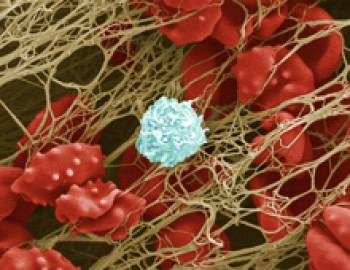Gene Therapy Helps Patients with Hemophilia
Gene Therapy Helps Patients with Hemophilia
A single dose of an experimental gene therapy boosted production of a missing blood-clotting factor in people with hemophilia, a new study shows. The therapy might give patients a long-term solution for preventing dangerous bleeding episodes.
Hemophilia is a rare, inherited disorder in which blood is unable to clot normally. As a result, people with hemophilia tend to bleed more than others after injury. They may also bleed without warning inside their bodies. This bleeding can damage organs and tissues and may be life threatening.
During the clotting process, blood cells become trapped in a fibrous mesh,
which is formed with the help of clotting factor IX.
Image by Anne Weston, Wellcome Images. All rights reserved by Wellcome Images.
The main treatment, called replacement therapy, involves infusing missing clotting factor proteins into the patient’s bloodstream. These proteins help to restore normal blood clotting. But replacement therapy often must be repeated regularly, and it carries other risks.
To find an alternative, researchers from the University College London and St. Jude Children’s Research Hospital led a team that investigated a potential gene therapy approach. The research, funded in part by NIH’s National Heart, Lung and Blood Institute (NHLBI), focused on hemophilia B. This uncommon form of the disease affects about 1 in 5 patients with hemophilia. Hemophilia B is caused by defects in the gene that codes for human clotting factor IX.
Scientists packaged a normal factor IX gene into a modified adeno-associated virus that targets liver cells. The liver is the only site that can produce a form of factor IX needed for the clotting process. The virus—acting as a delivery vehicle, or vector—was designed to transport the normal gene into liver cells and launch production of factor IX.
As reported on December 10, 2011, in the advance online edition of theNew England Journal of Medicine, 6 men with severe hemophilia B received one-time intravenous infusions of the gene vector at varying doses. Prior to the study, the men were producing clotting factor IX at less than 1% of normal levels. They had been receiving the standard treatment for their condition: infusions of manufactured factor IX protein several times a month.
After gene therapy, each patient generated factor IX at between 2% and 11% of normal levels. In the short-term follow-up period (6 to 16 months), 4 of the 6 men no longer needed factor IX infusions for routine bleeding. The other 2 patients needed factor IX infusions less often than before the study
“Hemophilia has long been one of the disorders thought most likely to be correctible with gene therapy, but previous approaches to deliver the gene have been disappointing,” says NHLBI Acting Director Dr. Susan B. Shurin. “Results from this study represent a promising step toward making gene therapy a viable treatment option for hemophilia B. If future studies support these findings, it would bring a significant improvement in the quality of life for those living with the disease.”
###
* The above story is reprinted from materials provided by National Institutes of Health (NIH)
** The National Institutes of Health (NIH) , a part of the U.S. Department of Health and Human Services, is the nation’s medical research agency—making important discoveries that improve health and save lives. The National Institutes of Health is made up of 27 different components called Institutes and Centers. Each has its own specific research agenda. All but three of these components receive their funding directly from Congress, and administrate their own budgets.



















